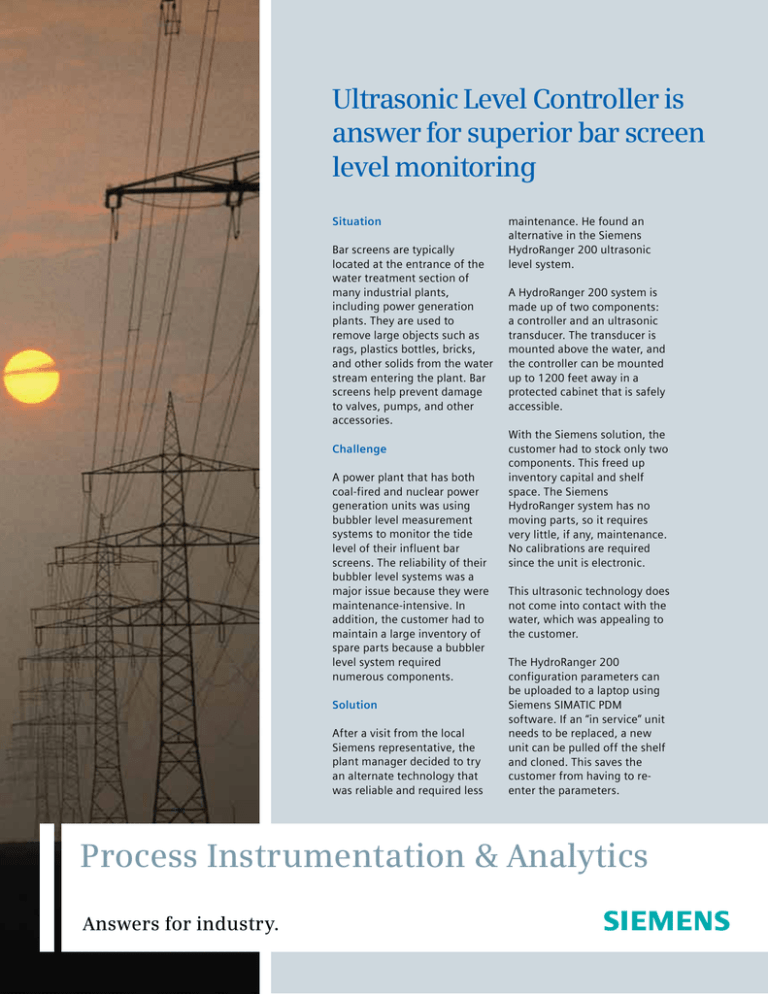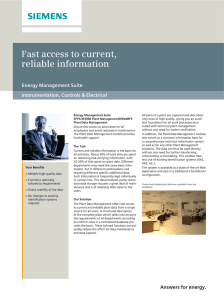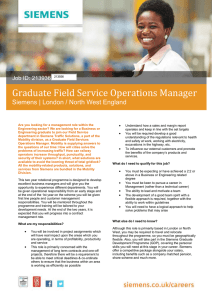
Ultrasonic Level Controller is
answer for superior bar screen
level monitoring
Situation
Bar screens are typically
located at the entrance of the
water treatment section of
many industrial plants,
including power generation
plants. They are used to
remove large objects such as
rags, plastics bottles, bricks,
and other solids from the water
stream entering the plant. Bar
screens help prevent damage
to valves, pumps, and other
accessories.
Challenge
A power plant that has both
coal-fired and nuclear power
generation units was using
bubbler level measurement
systems to monitor the tide
level of their influent bar
screens. The reliability of their
bubbler level systems was a
major issue because they were
maintenance-intensive. In
addition, the customer had to
maintain a large inventory of
spare parts because a bubbler
level system required
numerous components.
Solution
After a visit from the local
Siemens representative, the
plant manager decided to try
an alternate technology that
was reliable and required less
maintenance. He found an
alternative in the Siemens
HydroRanger 200 ultrasonic
level system.
A HydroRanger 200 system is
made up of two components:
a controller and an ultrasonic
transducer. The transducer is
mounted above the water, and
the controller can be mounted
up to 1200 feet away in a
protected cabinet that is safely
accessible.
With the Siemens solution, the
customer had to stock only two
components. This freed up
inventory capital and shelf
space. The Siemens
HydroRanger system has no
moving parts, so it requires
very little, if any, maintenance.
No calibrations are required
since the unit is electronic.
This ultrasonic technology does
not come into contact with the
water, which was appealing to
the customer.
The HydroRanger 200
configuration parameters can
be uploaded to a laptop using
Siemens SIMATIC PDM
software. If an “in service” unit
needs to be replaced, a new
unit can be pulled off the shelf
and cloned. This saves the
customer from having to reenter the parameters.
Process Instrumentation & Analytics
Answers for industry.
Benefits
• Non-contacting – The transducer is immune to problems caused
by suspended solids, harsh corrosives, grease, or silt in the
influent, all of which effect the reliability of a contacting
measurement technology.
• Simple setup – It’s easy to install and program with the handheld
infrared programmer or via SIMATIC PDM.
• Sonic Intelligence® – Our field-proven echo processing algorithms
guarantee the most reliable performance available.
• Unmatched beam angle – A strong pulse and sensitivity in a
compact beam make our ultrasonic transducers the most reliable
in the industry.
• Million-in-one – Our products have the field experience of over a
million points of level built into every device.
• Global network – sales and support in your neighborhood. Our
extensive global coverage means you get sales and support when
and where you need it.
Siemens Industry, Inc.
Industry Automation
3333 Old Milton Parkway
Alpharetta, GA 30005
1-800-964-4114
info.us@siemens.com
www.usa.siemens.com/pi
About the HydroRanger Controller
HydroRanger 200 is an ultrasonic level controller for up to six
pumps that provide control, differential control, and open
channel flow monitoring.
For water authorities, municipal and industrial water and
wastewater plants, the HydroRanger 200 level controller is an
economical, low-maintenance solution delivering the control
efficiency and productivity needed to meet today’s exacting
standards. It offers single-point monitoring with all models, and
optional dual-point monitoring with the 6 relay model. It has
digital communications with built-in Modbus RTU via RS-485.
Subject to change without prior notice
Order No.: PICS-00045-0410
All rights reserved
Printed in USA
©2010 Siemens Industry, Inc.
The information provided in this brochure contains merely
general descriptions or characteristics of performance
which in case of actual use do not always apply as described
or which may change as a result of further development
of the products. An obligation to provide the respective
characteristics shall only exist if expressly agreed in the
terms of contract.
All product designations may be trademarks or product
names of Siemens AG or supplier companies whose use by
third parties for their own purposes could violate the rights
of the owners.






